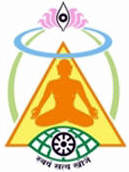
International Preksha Meditation Camp
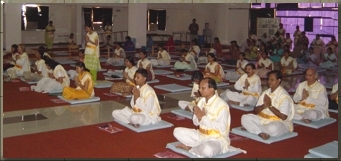
For nine days in October, from 7th to 15thOctober 2003, about 120 delegates from ten countries - India, USA, UK, Germany, Russia, Tajikistan, Moldova, Ukraine, Nepal and Malaysia - came together to learn how to practice Preksha Meditation or to deepen their knowledge for a more conscious practice. They had reached Surat from different parts of the world, but all together were decided to dedicate nine days of their life to evolve their true self and to search the truth themselves by looking inside.
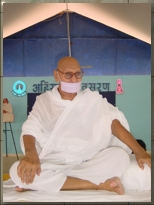
As announced, daily schedule was expected to be followed strictly by all residentials, starting with first meditation session at 5.15h a.m. (wake-up at 4.30h a.m.), then Guru Darshan of His Holiness Acharya Mahaprajna (spoken: Mahapragya), Yoga-Asanas, Pranayama and afterward breakfast.
After breakfast at 9.00h a.m., lectures on Preksha Meditation were given audio-visually by Muni Mahendra Kumar, professor of Preksha Meditation, who himself was present. From 10.00h a.m. to 11.00h a.m. a contemplation session took place, Anupreksha by Samani Shardapragya, followed by Kayotsarga, relaxation with self-awareness from 11.00h a.m. to 12.00h by Muni Kishan Lal, also professor of Preksha Meditation.
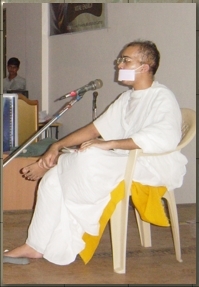
After a lunch break another meditation session guided by Munishree Kumar Shraman took place at 2.00h pm. Muni Kumar Shramanji is a monk of 22 years who had joined the order at the age of nine. The meaning of his name is ‘Little Saint’. During one of their ramblings, Muni Jay Kumarji and him got the inspiration to organize an International Preksha Meditation Camp. It turned out that their idea was perfect.
From 3.00h p.m. till 3.45h p.m. followed a spiritual talk of His Holiness Acharya Mahaprajna.
From 4.00h p.m. to 5.00h p.m. the participants received a lecture in body science - anatomy - by Dr. G. L. Jain from Udaipur who had given an introduction and welcome speech on the first day also.
A break for personal work and dinner followed, and at 6.30h p.m. for about ten minutes wakeful walk from the place of accommodation and meals to Darshan of His Holiness Acharya Mahaprajna at City Lights Terapanth Bhawan (Terapanth center).
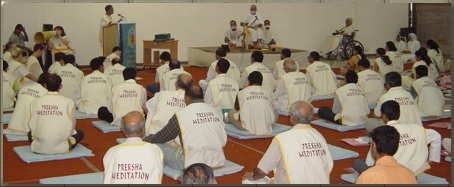
After this, from about 06.45h p.m. to 7.00h p.m. Saman Ashwinpragyaji articulated sacred wishes according to Jain tradition, followed by Preksha Meditation Session with Yuvacharya Mahashraman.
The daily schedule was concluded with questions to professor Muni Mahendra Kumar.
It was recommended to close the day with appraisal and recording of the day’s experience. Every participant got a form with five categories: ‘Living in present’, ‘Act-not react’, ‘Be friend to all’, ‘Practice of silence’, and ‘No overeating’. The participants could then judge themselves with a score ranging from 10 (‘practiced all the time’) down to 0 (‘totally forgot’).
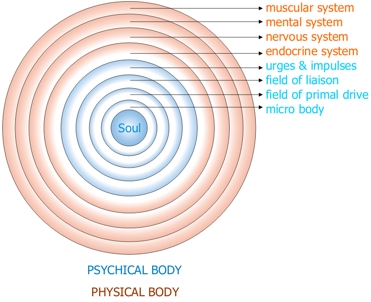
On the first day, the participants registered and were accommodated before pledging for fulfillment of prerequisites for Preksha Meditation witnessed by His Holiness Acharya Mahaprajna.
After lunch, Dr. G. L. Jain (Udaipur) gave an introduction to Preksha Meditation in his first lecture, starting with the postures of body, legs, arms, hands, fingers and head. Any sitting, lying or standing position (which is best because of free energy flooding) that can be maintained during the whole meditation session is acceptable.
Preksha Meditation brings about changes on every level of personality and leads to perception of the self, an important pre-condition to fulfill spiritual aims. Preksha means literally ‘to see’ and ‘to perceive’, since seeing and perceiving are parts of the mental processes as are thinking and reflecting. In this context, meditation means concentration on the process of perception, whereas concentration generally relates to the thinking process.
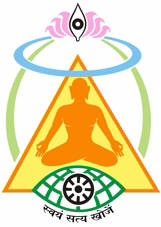
How can we perceive our self and concentrate it on the perception of the self?
There are seven levels on which the self can be experienced and perceived. The introductory aphorism of Preksha Meditation ‘Sampikae Apaga Mappa Enam’ - See your self through your self, perceive and realize the deepest and highest levels of your consciousness by your conscious mind - is related to every single aspect of the seven levels:
- Body
- Breath
- Vital Energy
- Mind
- Psyche
- Emotions
- Psychic Colours (inside) - Aura (outside)
In Preksha Meditation, the self concentrates on every single level of the seven and simultaneously all the seven levels on the self. Along with this process of concentration, we have to refrain from likes and dislikes, thereby bringing the self into a balanced situation. This enables the self to exist in its pure form, without the contaminations of likes and dislikes. Released from these contaminations, the self detaches itself from the bondages of Karma and is able to perceive itself.
In Preksha Meditation, we try to emancipate ourselves from outer influences in order to use our full life energy from inside to realise our own aims in life. Increasing quality of life results in a well balanced personality.
Each of the participants introduced him or herself with some words to His Holiness Acharya Mahaprajna, who had retrieved this forgotten method of Jain meditation in the Agamas, the teachings of Lord Mahavira. Nearly fifty years ago, Acharyashree together with a team of dedicated monks and nuns had retransmitted it from ancient Prakrit into modern Hindi language and experienced it himself by referring his findings to modern science for nearly two decades before presenting it to public.
In the past thirty years, many thousands of people in India enjoyed the fruits of his results in research during ten-days-meditation-camps, its translation into English language was inspired by him. The first International Preksha Camp was organised in 2002 at Ahmedabad, Gujarat, the third International Camp is planned for October 2004 in Siriyari, Rajasthan.
We then had our first meditation session with Yuvacharya Mahashraman on perception of the body. For giving an impression of the spiritual inspirations we could experience, I describe my own experiences during this session:
My motionless body had no importance anymore. A multicolored cloud enwrapped me. I followed the vibrations of his voice guiding me deep inside myself where I perceived the subtle vibrations of vital energy all over the body. When I listened to Sharan Sutra (aphorism for resort) every single cell of my body was vibrating with energy:
| Arhante Sarenam Pauerjami | I take refuge to the Omniscients |
| Siddhe Sarenam Pauerjami | I take refuge to the liberated who attained salvation |
| Sahu Sarenam Pauerjami | I take refuge to the saints |
| Kevali Panatam Sarenam Pauerjami | I take refuge to the promulgations of the Omniscients |
I heard the blood whooshing in the veins and felt bliss and happiness.
After this session, everyone went to ‘sleep with awareness’ (Yog Nidra). Next day at 4.30h a.m., I woke up. Right time to be ready for meditation at 5.15h a.m. As an aftereffect of evening meditation I got aware that something happened inside my body, it was a sensation like recovering from fever, but without any feeling of weakness. I recognized it as a process of purification, initiated by the presence of the saints and the practice of meditation together with the nearly 120 members of the group. The whole of my body was pulsated by little tornados of vital energy, an impression I had never felt before.
Morning lectures by Prof. Muni Mahendra Kumar were titled ‘Theory of Preksha Meditation and philosophical background of various aspects’. The aspect treated in the first lecture was Kayotsarg, the first step of Preksha Meditation. The literal meaning of Kayotsarg is ‘to leave the body’. The left body is a motionless body, and such a motionless body is generally a dead body, so leaving the body is a simulation of death. Why this?
In Kayotsarg we aim at experiencing the self separated from the body to practice perception of the self or soul. Perception of the soul is necessary for spiritual development as to disband Karma. Karma is bound to mental and physical activities that create vibrations in body and mind. These subtle vibrations attract karma particles adhering to the soul like very subtle grains of dust. The vibrations of mind and body are also known in science. They are generally explained as an over activity of the nervous system.
All day long, we accomplish mental, psychic and emotional actions by and by, thereby generating tensions due to this permanent exposure. Kayotsarg helps the mind to relax. Starting with the big toe of the right foot and leading up to the highest point of the head, the whole body gets relaxed in Kayotsarg, step by step, via autosuggestion.
While the body is motionless, physical and mental activities are reduced to the minimum: the breathing slows down, the blood sugar level drops, metabolic processes and activities of the brain are reduced, its electrical impulses are produced in alpha waves. Our operational efficiency is increasing as well as our capacity to bear heat, cold and pains. Our capacity of concentration augments, perception of Aura becomes possible, as well as development of wisdom concerning distinction of right and wrong in theory and in practise.
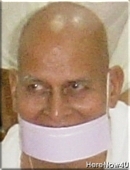
Fully aware of the benefits of Kayotsarg, everyone was ready for Anupreksha by Samani Shardapragya, who is blessed with a beautiful voice making everyone eager to start with the work of refinement and to repeat ‘My forbearance is being increased’ and ‘My equanimity is being increased’. After this, a session of Kayotsarg with Muni Kishan Lal relieved us from the tensions of adapting to a new surrounding and a new rhythm of life starting in early morning and concentrating our whole personality on meditation.
The afternoon meditation session was followed by a spiritual talk of His Holiness Acharya Mahaprajna on ‘Continuity of Change’. The world of objects is changing continuously, suffering and bliss being affiliated with change. We feel happy in association with something positive and unhappy in separation from it. Analogously, when we are separated from something negative, we feel happy whereas we feel unhappy when are facing something negative.
Then Acharyashree talked on thought and action in the context of change. Generally thoughts are not realised, thoughts leaving an impression on our consciousness create the same reality inside us as an action. Anupreksha enables us to transform a thought into an impression. Thoughts can be generated by us or lent from others, but an impression cannot be adopted from others.
Who controls our mind? Spiritually seen, karma body does, our thoughts and actions are generated from its subtle vibrations. When we want to acquit ourselves from these mechanisms, we have to act on the constituents of the brain. Anatomy is an important tool in Preksha Meditation providing the knowledge how to bring about the change.
This was a brilliant introduction into the afternoon anatomy lecture by Dr. G. L. Jain, Udaipur. He acquainted us with nature’s miracle called the human body, starting with the basics of cells, tissues, skin and organs. His representations on the human body and its systems gave a summary on the body processes and functions and how they are interrelated. Constant practice of meditation alone can bring about perception of all these subtle activities generally unaccompanied by consciousness.
All days during the camp were structured almost alike, except for the first, the last, and October 15th, birthday of Dr. Abdul Kalam, the President of India.
President Kamal celebrated some hours of his birthday in presence of His Holiness Acharya Mahaprajna. The ‘ Surat Spiritual Declaration ’ [SSD] was handed over to him; its five key elements were signed by all attendant religious leaders. As head of politics and science on one side and of religion on the other, the prime minister and Acharyashree had presided to a gathering of thirteen religious leaders and scholars for realising the ‘GARLAND PROJECT’ for ‘Unity of Minds’ and for creating ‘Enlightened Citizens’ in India.
The delegates of the International Preksha Meditation Camp had the chance to participate in this event. H.H. Acharyashree presented me to President Kalam, which gave me the chance to express my heartfelt birthday to him. H.H. Acharyashree presented the German translation of the brochure 'Acharya Mahapragya - Eine lebende Legende' (Acharya Mahapragya - A Living Legend) to him, which was done by me.
On the last day, the camp ended after lunch.
Prof. Muni Mahendra Kumar’s lectures always opened our minds to rather theoretical and philosophical background informations on Preksha Meditation.
The next aspect was Antaryatra, internal trip, the second step of Preksha Meditation. The technique of the internal trip is easy to practise: the consciousness is concentrated on the centre of energy at the end of the spinal cord and is then moved upward the spinal cord to the centre of wisdom, the highest point of the head. We allow our mind to rise and to fall the spinal cord up and down and synchronise the movements with our breath, going down by inhaling, moving upward by exhaling.
After some time, we are able to perceive the subtle vibrations of energy in the spinal cord and of our brain. This second step of Preksha Meditation enables us to increase concentration.
Science explains this process as focusing the mind on central nervous system. Focusing the mind on central nervous system enables it to influence consciously and to harmonise flows of vital energy. Harmonious flow of vital energy results in an equanimous frame of mind without likes and dislikes. This balanced attitude dissolves karmic bondages that are enforced by attachment and diminished by detachment. One’s view of the world is changed and hindrances of spiritual progress are deleted.
In addition to this, the upward oriented flow of energy gets aggravated which results in activating the ability to act instead of reacting and to transform our negative urges and impulses.
This aspect was followed by third step of Preksha Meditation, perception of body or psychic centres or psychic colours or followed by Anupreksha.
Perception of body focuses our attention on the body part by part. In this process we perceive the body together with the soul, for the body is affiliated with the soul. The body is only one of the seven levels on which the soul can be perceived. We experience the sensations of vital energy necessary for all activities without like and dislike. Increasing concentration will enable us to observe the subtle vibrations of the continuous flow of Prana (Prandhara). There are five different categories of Prana operating on five different regions of the body:
| Rectum | - | Coccyx |
| Navel | - | Stomach |
| Heart | - | Head |
| Nose | - | Face |
| Skin | - | Whole Body |
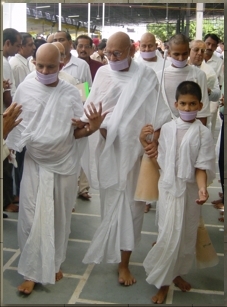
For balanced well-being, these five categories in the different regions of the body have to work together harmoniously. This process is supported by perception of the body. The different body systems such as skeletal, muscular, digesting, circulatory, or respiratory system as well as nervous, endocrine, reproductive, and excretory system optimise and coordinate their functions. Not only is it possible to perceive the subtle vibrations of Prana, but also the subtle vibrations caused by the organs being at work. In the beginning, this facility is not yet developed, but increasing concentration on perception will provide it.
Perception of the body supports perception of body and soul as separate entities. This liberates the soul from its karmic bondages. When we are concentrated on certain parts of the body, we feel pain or suffering. In this situation, it is important not to react to the sensations of the body. When we do not react, we are not engaged in experiencing the reaction. Mind and soul are liberated from their karmic bondages and perceive equanimity as the original nature of the self. Then the mind is free from like or dislike and from the resulting karmic attachments.
The gross body is a means to reach the bio-electrical body and through that the karmic body that is our enemy because it prevents spiritual advance.
It is very difficult to communicate with the most subtle bodies, but it becomes possible with increasing concentration. Transformation and even dissolution of the karma body is possible realising change in regard to liberation of the soul. It is the task of the karma body to hinder the soul from knowing its true nature and to maintain the false supposition ‘I am the body’ and to bind it deeper and deeper in the karma of the material world
When we bow down at the end of the meditation session with the words 'Vande Sachcham'; (Prakrit: I bow down in respect of truth) we give expression to the fact 'I am the soul, I am not the body'.
| Level | Psychic Centres | Location | Endocrine System | |
| 1 | Centre of Energy | Shakti Kendra | Bottom of Spinal Cord | Gonads |
| 2 | Centre of Health | Svasthya Kendra | 6 inch above Centre of Energy | Gonads |
| 3 | Centre of Bio-Electricity | Taijasa Kendra | Navel | Adrenal Gland |
| 4 | Centre of Bliss | Ananda Kendra | Near Heart | Thymus Gland |
| 5 | Centre of Purity | Visuddhi Kendra | Throat | Thyroid Gland |
| 6 | Centre of Celibacy | Brahma Kendra | At The Tip Of The Tongue | Taste |
| 7 | Centre of Vital Energy | Prana Kendra | At The Tip Of The Nose | Smell |
| 8 | Centre of Vision | Caksusa Kendra | Eyes | Vision |
| 9 | Centre of Vigilance | Apramada Kendra | Ears | Hearing |
| 10 | Centre of Intuition | Darshan Kendra | Middle of Eyebrows | Pituitary Gland |
| 11 | Centre of Enlightenment | Jyoti Kendra | Centre of Forehead | Pineal Gland |
| 12 | Centre of Peace | Shanti Kendra | Top Of The Forehead | Hypothalamus |
| 13 | Centre of Wisdom | Jnana Kendra | Top of Head | Cerebral Cortex |
Perception of psychic centres concentrates the mind on a psychic level. Focusing on the psyche, liberates the soul from attachments. The psychic centres consist on subatomic psychic particles and are connected with the endocrine system directing the endocrine orchestra. The endocrine system influences via hormones, the thyroid gland, the pineal gland, and the pituitary gland all our actions and reactions. For example, on anger the endocrine glands are responding with anger. Not only do they control the animal impulses and urges in human beings, but they also produce the hormones that enable individuals to transform them into human actions.
Perceiving the subtle vibrations of energy in the psychic centres results in lasting transformation, for it enables us to reach and influence our subconscious mind. Intellectual determination alone does neither help us to be the ones we could and should be, nor does it influence our emotional impulses descending from the endocrine hormones. The entrance to the emotional system lays in the limbic system. It is connected with our brain stem, which is not accessible to consciousness.
Managing the psychic centres helps us to transform spiritual aims into action by refining negative impulses. There are many of psychic centres all over the body, Preksha Meditation gives special relevance to thirteen of them. See their location in relation to the endocrine system:
It is important to concentrate on the psychic centers in upward direction from bottom to top, since otherwise prevalence of vital energies may cause troubles of nervous agitation and excitability.
In perception of psychic colours, consciousness is concentrated on the most subtle psychic level. Body, psyche and self or soul are of different consistence. The more subtle they are, the more difficult is it to perceive them, and the more refinement of perceptive concentration is required. The gross body consists of physical matter, psyche of subatomic psychic particles and the self or soul is pure conscious energy. As the psyche is communicating via endocrine system with the body, the communication between self and psyche produces psychic colours.
Psychic colours are different from physical colours. Physical colours are visible electro magnetic vibrations outside the body, psychic colours are invisible minusculest colour particles/waves generated from subtlest vibrations inside the most inner part of the body. They stimulate the raising of emotions respectively take influence on the flow of emotions.
Rays of psychic colours can also be seen on the outside, they are known as the Aura. According to our emotions, our aura is brighter or darker.
For practising Anupreksha, a certain capacity of concentration should be developed. Unlike in Preksha Meditation, the mind is concentrated on a special subject. Often we fall into an emotional struggle, when we get to know the facts of life. We know that all of us are mortal, but we are deeply aggrieved for a long time, when we loose a loved person. It seems that sometimes we never overcome certain losses. 'Anupreksha of Loneliness' helps us to realise that all familial or amicable relationships are temporary, and have to be given up, sooner or later.
Anupreksha therapy can be used against addiction, when it is practised for at least ten minutes daily for about three months. The method is simple, but effective: Aimed virtue has to be visualised, formulated, and expressed in six different but very similar variations. For realisation it has to be formulated nine times loudly, as well as mentally.
Unconsciousness is thereby reached via autosuggestion. In the spiritual tradition, this method is called Bhavana. It channels our instincts and impulses towards an internalised and formulated aim, which is integrated into the subconscient mind through repetition, if possible, at exactly the same time daily.
The morning schedule continued with a session of Anupreksha by Samani Shardapragya. Opened by the lectures, the mind now got occupied with a change of mental attitudes by Contemplation on Forbearance, Fearlessness, and Amity.
No doubt, these contemplations together with the following sessions of Kayotsarg by Muni Kishan Lalji contributed to the feeling that all of us belong to the big Preksha family without ignoring the fact that all of us are individuals with own experiences. We literally experienced unity in diversity.
During one session of Kayotsarg by Muni Kishan Lalji, we were asked to assist to our own funeral; during another we were guided in leaving the body. I give an impression of my experience:
Very relaxed I laid down and concentrated on Munishree’s voice. He recited some Mantras, and next I remember, is an impression of something behind my right shoulder. Turning my head, I recognised the earth getting smaller and smaller, which made me realise that I was departing with high speed. In front of me, I saw the moon. Nevertheless, I was still aware that my body still was in the meditation hall.
Then I remembered immediately all descriptions of journeys in outer space I had read in the books of Hermann Hesse, Rudolf Steiner and Franz Werfel. I was very pleased to experience it myself, for I had wished to do so for a long time. This reminded me of my astral body, I felt that I was inside it and catched a glimpse of the silver cord connecting it with the earth. When I flew above the moon, I realised that this was my first journey in my astral body and got a little excited by remembering a passage of Hesse’s ‘Game of glass beads’ where it is said that the astral body’s silver cord does not reach further than behind the moon. I felt confidence again when I heard Munishree’s voice, but preferred to get back. A good decision, for the session was over.
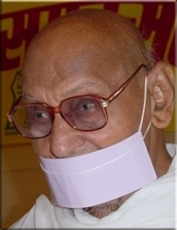
The spiritual talks of Acharyashree in the afternoon were always a source of inspiration to deeper comprehension of reality. Three of them I will describe at length.
Often we develop concepts in life and aim to the ultimate. When we get into troubles, we expect help from others, relatives or friends, which we often receive in practical life. However this is no lasting answer to problems. When there is no support from outside, only our own firmness can bring about solutions. Firmness is a powerful gate to our subtle inner. We practise Preksha Meditation for realisation of the self. It aims to establish inner harmony because only then we are in full possession of our inner power. Everyone has positive and negative tendencies at his disposal. We have to perceive both of them, and to refine the negative ones. In perception of breath we are meditating on either.
Taking breath from the left nostril has a cooling impact on the body system, and the right side of our brain is activated. The parasympathetic nervous system is connected with the left nostril. When it is in active mode, our sense of inferiority gets accentuated.
Taking breath from the right nostril has warming impact on the body system, and the left side of our brain is activated. The sympathetic nervous system is connected with the right nostril. When it is in active mode, our superior complex gets accentuated.
Both are harmonised by breathing alternately through both nostrils. During daytime we start with the left nostril, in the evening we tend to use the right nostril.
For realising truth, we have to recognise the fact that we live in two worlds, in the worlds of body and soul (or consciousness). There is no shelter outside. Shelter can only be given by a balanced self.
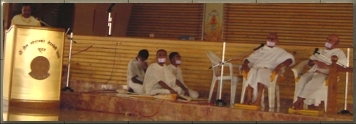
Individual and Society
It is difficult to describe the relationship between individual and society. Social sciences have always worked on this subject, but faced the problem of defining the individual. They did not consider self and ego as different concepts. Ego can define the individual, but the individual cannot define the self. In spiritual science we look on the self as the source of the individual.
In social sciences two questions are important: How the individual relates to itself, and how others relate to the individual. Someone who sits in deep meditation for hours, doing nothing than contacting the self, sometimes is declared crazy by other people. This shows that other people are not able to evaluate our own self, only we can do this.
Emotions and mind belong to the individual. By meditation only, individual consciousness can be developed. Pains and pleasures are also individual. Others can observe, if one enjoys or suffers, but cannot share the individual’s feelings.
The individual cannot only be seen as part of the social machinery, but should be considered as an independent being, constituting and influencing the society at the same time. Each individual can lift the social level of the whole society.
Meditation is very helpful for the refinement of the individual. In meditation, one sees only one’s own self, and not other people. In social life, it is equally important to see other people.
The individual communicates by sense organs and sense perceptions with society. When one sees oneself, the first step is to control the sense organs. The self can only be seen by the self, not by the sense organs. In meditation, we close the eyes softly and filter all sensory perceptions.
Every social interaction happens by means of sense organs. When our sense organs are active, we are social persons, when they are under control, we are spiritual persons. If we are social beings, why do we meditate? The answer can be found in the follwingdescribed in the following:
Once there was a president of a big company who had no time left for human encounters. When he retired and got plenty of time, he kept complaining that nobody came to see him anymore.
These experiences are rendering many people sad and unhappy. Those who know the ultimate truth, also know that every individual is alone, they do not feel sad anymore. Unhappy feelings are always based on social relations. Those who are able to differentiate between the ultimate reality of the individual and the relative reality of society are no longer unhappy. In social relations, everything is possible, and everything can happen. Therefore we have to differentiate carefully between conceptual truth of the world and ultimate truth of the individual.
Amity in Spiritual Life
In social life we consider someone a friend, if he helps us reaching our selfish aims. We consider him a foe, if he does not. A foe helping us changes into a friend, a friend who does not into a foe. In spiritual life, there are neither friends, nor foes. Amity in spiritual life is far away from selfishness, because we feel amity for all living beings.
In social life fifty out of hundred people are our friends, and the other fifty our foes. In spiritual life, ninety-nine out of hundred living beings are our friends, and in regard to the left one, we lack spiritual practise. Nobody is our foe.
Amity in social life means doing good to others. The meaning of amity changes in spiritual life. Feelings of amity contribute to our own joy,and feelings of enmity to our own damage. Talking bad of another person hurts and harms the one who talks, and not the other person.
Yet it is very difficult to understand that one is able to harm oneself. Spiritual amity is no get-together with others, but safeguarding of the own soul; it is the noble concept of not harming oneself. We are doing harm to ourselves when we react instead of acting, and mistake others for being responsible. In Preksha Meditation, we go inside to learn how to act instead of react.
Brain scientists have found that outside influences have no direct,but indirect impact on our behaviour. They are reaching us via hypothalamus, which is reacting immediately on them. For changing our life, we have to learn to be faster than our reactive impulses and to control our brain by our consciousness. Meditation on psychic centres is an easy-to-learn technique how to act consciously and on our own, instead of reacting automatically.
Yuvacharya Mahashraman ji gave a spiritual talk on
How to reach spiritual aims
The highest spiritual aim is the development of wisdom. To reach spiritual aims, it is important to be free from attachment, anger, and fear. In social life, we are attached to many objects and attracted by money and goods. When our house burns, we are very excited and sad. When our neighbor’s house burns, we are more equanimous. Attachment cannot be avoided in practical life, but it should be controlled.
Everybody knows how harmful it is to get angry. However, when obstacles appear to hinder the fulfillment of our desires, anger arouses. We should concentrate all our power to overcome this weakness. The scriptures advise peacefulness as a remedy. Contemplation of a peaceful person helps to develop peacefulness oneself.
In Preksha Meditation we aim at transformation of anger. Anger results from taking every word just by its meaning. We should try to find the superior principle governing the actual situation, look at it from this level, and perceive ourselves in the situation.
Fearless persons only die once, fearful persons die in every moment. Only fearless persons can practice non-violence (Ahimsa) and truthfulness. Fear comes up, when we think to get punished for something we did neglect, in spite of knowing that we should not.
There are plenty of situations that cause fear. We should consciously step into them to get used to the fact that fear is a part of life. In the Anupreksha variant of Preksha Meditation we try to develop fearlessness, also the recitation of mantras is very helpful to overcome fear.
This selection of lectures, meditation sessions and spiritual talks may convey an overview of how the II. International Preksha Meditation Camp processed. During nine extraordinary days, all participants tried to animate the complex knowledge given to them and to make it a part of their life. It was a gathering of people, aiming to refine themselves for giving more sense to their life. I was glad to meet them all.
At the end of the camp, every one of the participants felt part of the big Preksha Family, spread all over the world.
The organizational committee in Surat really did a great job. People had left their everyday tasks and duties to devote themselves to the noble sake of caring for all activities, coming along with the camp. Management, accommodation, food and transport were just perfect, everything was gently done with a smile. All participants highly enjoyed the legendary Indian hospitality, and had an unforgettable experience of ‘the wonder that IS India’. Thank you so much.
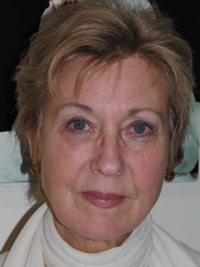 Editor Carla Geerdes
Editor Carla Geerdes